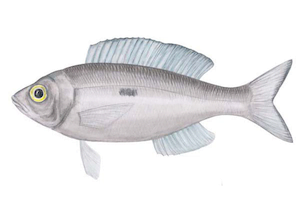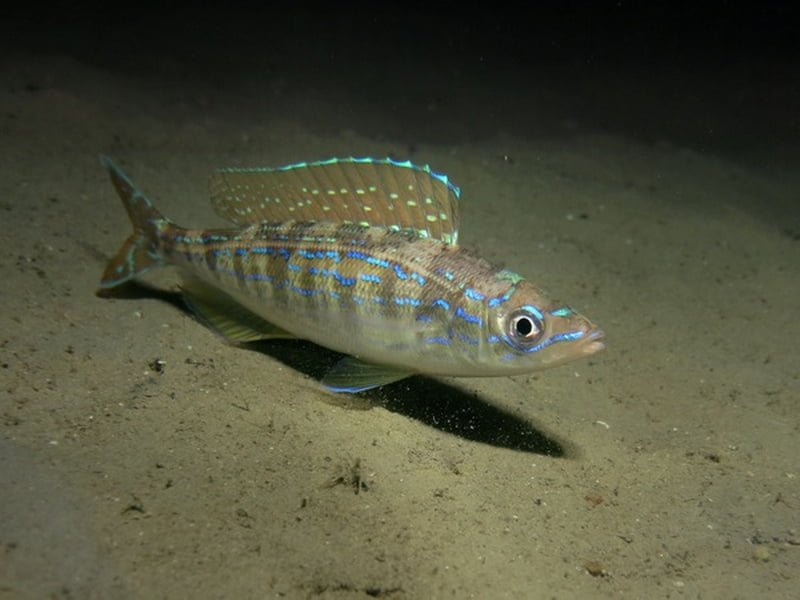Spicara Smaris
– Picarel –


| Scientific classification |
|---|
Spicara smaris
(Linnaeus, 1758)[1]
| Kingdom: | Animalia |
| Phylum: | Chordata |
| Class: | Actinopterygii |
| Order: | Perciformes |
| Family: | Sparidae |
| Genus: | Spicara |
| Species: | S. smaris |


Spicara smaris, one of the picarels, is a species of ray-finned fish native to the eastern Atlantic Ocean, the Mediterranean Sea and the Black Sea. It grows to a maximum length of about 20 cm (8 in); females are usually smaller than males.
Description
Spicara smaris grows to a maximum length of 20 cm (8 in) but a more common maximum size is 15 cm (6 in). It is a more slender fish than the closely related blotched picarel (Spicara maena) and can be distinguished from that species by having 75–81 scales along the lateral line rather than 68–70. Its back is grey-brown and it has silvery flanks with a large black spot located above the tip of the pectoral fin. Male fish are usually larger than females and have small blue spots scattered across the dorsal and anal fins.[3]
Females, smaller, have a maximum length of 15 cm, while males can reach 20 cm and more rarely 25 cm.
Its body has an oblong shape, slightly compressed laterally. It is slender, its height is contained 3.7 to 4.7 times in its standard length (without the tail) and represents 17 to 20% of its total length (with the tail).
Its head is longer than the height of the body . Its very pointed mouth can at times form a tube thanks to a very protractile upper jaw *. The jaws have small villiform teeth * and sometimes small vomerine teeth *.
The muzzle and interorbital region are bare, the rest of the head and body covered with weakly ctenoid scales *. The operculum * is thornless.
The lateral line * is continuous from the back of the eye to the caudal. It wears 75 to 81 scales.
The picarel has a single dorsal fin comprising 11 or 12 spines and 10 to 12 soft rays. The upper edge of this fin is almost continuous, with no notch between the 2 types of rays. The anal fin has 3 spines and 8-10 soft rays. The pelvic cells have a thorn and 5 rays. The caudal is forked.
Its coloring is very variabledepending on age, sex, season and it changes between day and night. The back is gray blue, gray yellow, gray brown to reddish brown; the sides and the belly are silvery. A black rectangular spot is usually present below the lateral line towards the end of the pectoral fin. This spot is less marked in some individuals and at night.
The young are less colorful, with a blackish back, a silvery belly. The flanks show light, irregular vertical stripes and the fins are not colored yellow.
The adults, and especially the males, present on the upper part of the body and the middle of the flanks 7 to 8 horizontal lines alternately blue and yellow and sometimes darker vertical bands, not very marked, ending in a fork under the dorsal. The anal fin is adorned with blue and yellow stripes, the dorsal and caudal fins being less colorful.
The male in nuptial livery has a slightly taller body , brilliantly colored , with dotted blue horizontal lines and dots on the head and flanks, as well as on the fins which are further edged with blue.
Distribution and Habitat
Spicara smaris is native to the subtropical eastern Atlantic Ocean including the coasts of Portugal, the Canary Islands and Morocco, the Mediterranean Sea and the Black Sea.[4] It is usually found in seagrass meadows and over sandy and muddy seabeds. Its depth range is generally 15 to 170 m (49 to 558 ft) but it has been recorded at depths of 328 m (1,076 ft) in the eastern Ionian Sea.[1]
Biotope
Spicara smaris is a marine fish from coastal waters, usually present between 15 and 170 m, but it can ascend within 5 m and is reported up to 328 m in the Ionian Sea. It approaches the edge during the summer season and moves away in the fall when the water cools.
During the day, picarels generally form large schools, swimming in open water, above seagrass beds, sandy or muddy bottoms and sometimes rocky bottoms. At night, they disperse to remain motionless on the bottom, adopting a nocturnal livery.
Similar Species
The picarel closely resembles the other species of the genus Spicara : the mendola Spicara maena , with a taller body and less elongated with a head of a length less than the height of the body and whose back is bluish gray, greenish.
The lookout picarel, Centracanthus cirrus Rafinesque, 1810, is a fish more rarely encountered while diving. It has a slender body and a pointed muzzle but it is distinguished from Spicara smaris by the absence of the black rectangular spot and by its dorsal fin very indented between thorny rays and soft rays.
Biology
Spicara smaris is a sociable fish, forming large groups with others of its species.[1] It is a protogynous sequential hermaphrodite, individuals maturing as females and becoming males at some later point.[5] All individuals over about 17.9 cm (7.0 in) are male and the maximum age for a male is six years while for a female it is four.[6] Breeding takes place once a year and the colour of a male becomes brighter at this time. The male will scoop out a nest in soft sediment in which the female will lay eggs. The male then guards these until they hatch, after which time his bright colours fade and he rejoins other schooling fish.[5]
Alimentation
Spicara smaris feeds on zooplankton * and small benthic invertebrates * (molluscs, crustaceans, worms, etc.).
Reproduction
Hermaphrodite *, protogyne *, Spicara smaris first female reaches sexual maturity around 2 years, then becomes male at 3 years.
During the breeding season, at the end of winter and in spring (February to May and sometimes from July to September in the Black Sea) a large number of individuals congregate on the sand at the edge of seagrass beds. The males in nuptial livery dig, by turning and using their caudal, cup-shaped nests. Then begins a parade; the male will attract one of the females swimming above the nest and encourage it to lay eggs in the center of it. A female produces, depending on her size, between 2,000 and 12,000 eggs. After fertilizing the eggs, the male will remain on the nest to ventilate them, protect them and chase away intruders such as wrasse and serrans. At the end of the incubation period, the males lose their beautiful colors and gather in schools to go to feed.
According to JG. Harmelin, picarel spawning grounds can bring together thousands of nests side by side.
Associated Life
Predators: among the fish the capon Scorpaena scrofa and the striped lizardfish Synodus saurus .
Internal parasites: various nematodes including Ascaris sp. and Philometra spicarae .
External parasites: anilocres .
Various Biology
The oldest females can be 4 years old and the oldest males 6 years old.
The genus Spicara has posed problems for systematicians in describing species, in particular because of variable coloring. The number of described species had greatly increased after Linnaeus but, since 1950, studies have shown that a simplification was possible and even, in 1971, by the study of crystalline lenses, that this genus probably only included two local species. S. maena and S. smaris .
As Food
Spicara smaris is a popular food in parts of southern Italy, Dalmatia, and Greece.[7] In Dalmatia, salted picarel, slana gira, are popular.[7] Picarel is one of the five most commonly caught fish in Cyprus.[8] In Greece and Cyprus, picarel, marida, is generally battered and fried, and eaten whole, including the head, tail, and bones.[9]
Further Information
Fishing and use: the picarel is the object of artisanal and sport fishing and by-catches of semi-industrial fishing.
Present in local markets, its flesh is more or less appreciated because it has a particular taste and it is rich in bones like that of other species of its family.
Picarel is marketed fresh, chilled or canned. Until recently it was often stored dried and smoked. It is mainly eaten in frying or in fish soups.
In Roman times, picarel was used to make garum, a condiment very popular in Rome, obtained by macerating whole fish with its viscera in a large amount of salt. Garum was used in many dishes.
Spicara smaris was removed from the family Centracanthidae and placed in family Sparidae in 2014.[1]

















































































































































































































































































































































































